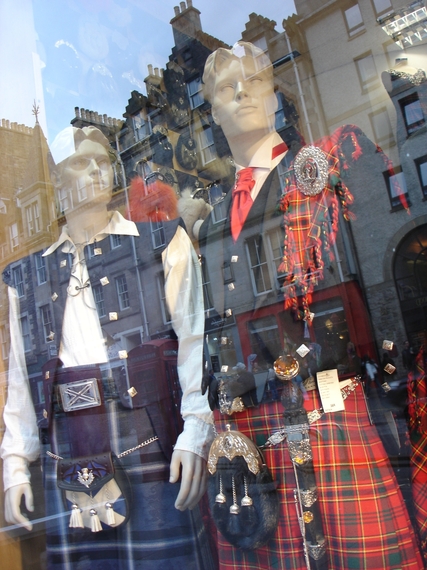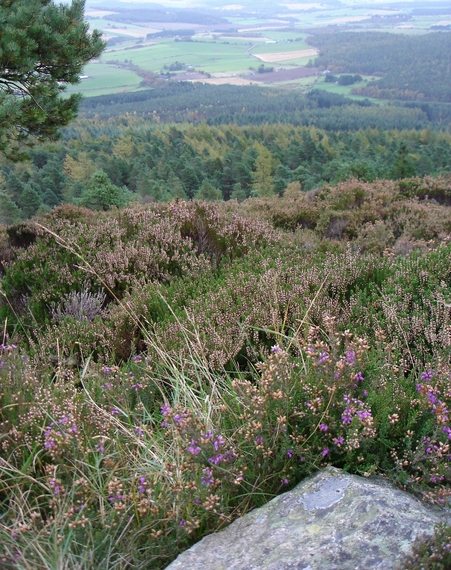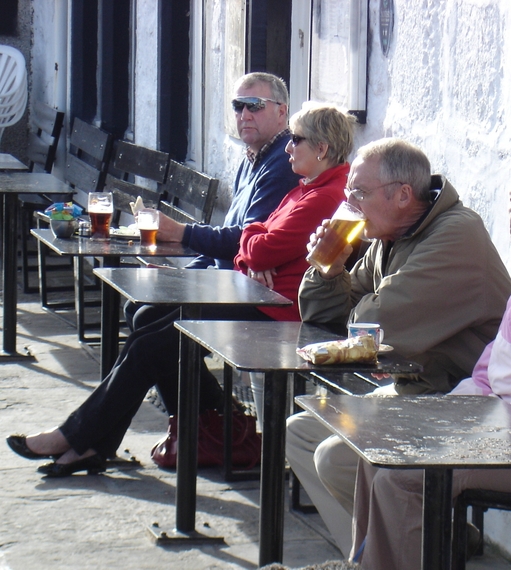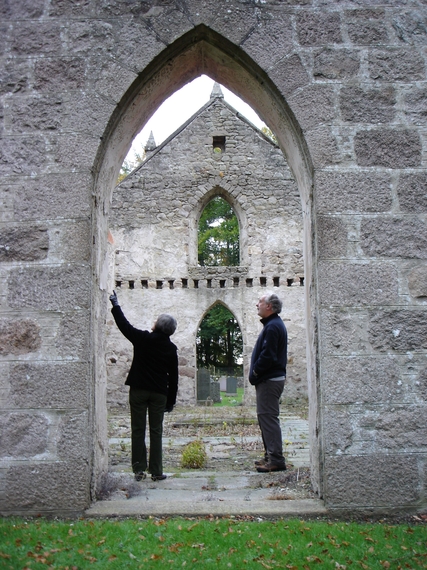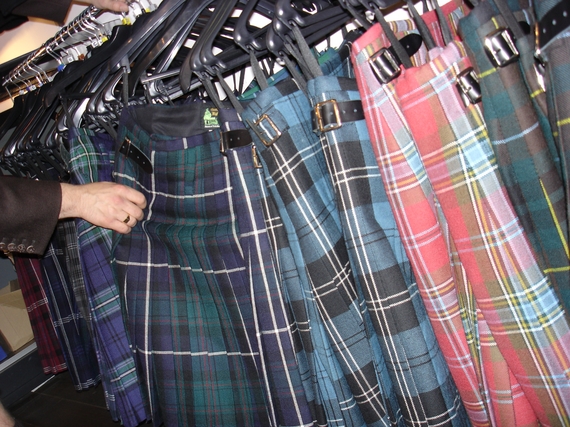If you're a fan of edgy, Scottish-made movies, you might imagine that traveling here is like jumping through the screen into the bleak, urban landscapes of Trainspotting or Shallow Grave. And as far as Scotland's biggest city, Glasgow, is concerned, even the peat-smoky sound of the word evokes images of vast red-brick slums and empty berths at once-bustling shipyards.
Imagine what you like, but Glasgow has been busy brushing the soot off its sandstone and washing behind its no-longer-industrial ears. What has emerged after decades of careful restoration is a Victorian city where you can breathe the air, not of coal-furnaces, but of Mary Poppins-style British Empire grandeur. Where you can wander -- as I did, a few years back -- in parks full of holly trees and odd, glass-paneled follies. And where you are tugged along in the currents of a street life that is more vibrant than Edinburgh's, and more authentically offbeat than a lot of what you will find in London.
The name Glasgow literally means "dear green place" and the city claims to have more park land per square mile than any other its size. Glasgow Green, Britain's oldest park, is edged by the River Clyde and its northern tip points you to the city center and to the glowering Tollbooth Steeple (where the heads of hanged criminals were once impaled on spikes). The Botanic Garden places you in the thriving, university-centered West End and delivers you to its Kibble Palace -- not a mansion devoted to dry dog food, but, in fact, an elaborate Victorian-style winter-garden with walls and domes of glass.
The grandest green space of all is Kelvingrove Park, also in the West End. Following one of the paths that wind across it, you climb steep hills as if you were on a moor and pass ponds chattering with magpies and ducks. When you come over a rise near the park's western side, the sky is suddenly crowded with the almost Kremlin-like cupolas of the Glasgow Art Gallery and Museum.
Here's the Bird that never flew
Here's the Tree that never grew
Here's the Bell that never rang
Here's the Fish that never swam
Bird, tree, bell, fish. These images show up on Glasgow's coat of arms, on weathervanes here, on decorative ironwork, and even on the lampposts of the city. And because the mysterious rhyme refers to the miracles of St. Mungo, Glasgow's patron saint, even in this disbelieving day local people are delighted to recite it to you if you let them.
Many of Britain's most imposing naval ships were launched from Glasgow shipyards, and ultimately, state-of-the-art ocean liners such as Cunard's Queen Mary and Queen Elizabeth. My Scottish aunt remembers being taken down to the River Clyde as a little girl to see the flagship Queen Mary as it was being soldered together. A welder strolled over to tell her her first off-color joke: "Why do fish swim up the Clyde?" he asked. "To see Queen Mary's bottom."
Between 1870 and 1915, Glasgow not only excelled in shipbuilding and international trade, but it ranked as one of the wealthiest cities in Europe. It was during this "golden age" that a nearly unknown local architect named Charles Rennie Mackintosh went about the business of creating -- through public and private buildings, furniture and graphics -- a kind of design universe that rivals what Frank Lloyd Wright was producing in America.
Coming across Mackintosh's remarkable Glasgow School of Art (1899) on Renfrew Street downtown, you'd swear from certain angles that you were looking at something dreamed up in the late 1950s. But walk around to the front, and the building turns into the perfect blend of graceful Art Nouveau curves and the straight lines of pure modernism.
Contemporary Glasgow seems to me a rare treat because it has its own way of talking and eating and arguing, and strutting around. Traveling here is like visiting Prohibition-era Chicago or Brooklyn, let's say, in 1956, with the Dodgers in the thick of yet another heart-wrenching Series.
This is a city that thrills to its own news stories, not those of celebrities across an ocean or those of its relatively buttoned-up English neighbors to the south. Every other Glasgow street-corner has a paper man hawking the Scottish Daily Mail or some other tabloid advertised in hastily-printed banner sheets that tell you the scandal of the day.
"Fake One Pound Coins Flood City" yelled out one little kiosk that I passed, and less than two blocks later, I almost fell over another: "Skinny Dip Teacher Cleared of Having Affair With Pupil." But whether you're riding on the city's ear-splitting, bright-orange underground or trying to hail a cab or double-decker bus, the news men are sure to be drowned out by other Glaswegians offering you a friendly tip or otherwise gunning for your attention.
One bus driver I had swiveled around to shout that we were passing "Glickman's Sweetie Shop" which, he claimed, was run by "two lovely older ladies." In fact, he said, "Mrs. Glickman is waving to us as we speak." Sure enough, I thought I saw the vague outline of a waggling palm behind a window stacked with Cadbury chocolates and McVities shortbread, although I couldn't be sure. "They're quite modern, too," the driver confided to me. "If you can't get to Glickman's, you can look them up on their Internet address."
And then there are the one-of-a-kind expressions that pop out of the mouths of Glaswegians -- words and phrases that are not heard elsewhere in Scotland and may send you scrambling for a language dictionary that does not exist. The word "bahookie," for example, refers to a person's rear end; a "Glasgow kiss" means a head butt; a "low flyer" is a shot of Famous Grouse-brand scotch; a "lumber" is a bar pickup; and the phrase "pure dead brilliant" means something along the lines of truly amazing.
"D'you not want a pokey hat?" I heard a mother asking two unhappy kids who were standing on the sidewalk in front of a museum. As things played out, I learned that a "pokey hat" had nothing to do with dressing up, but referred to ice cream cones which you can buy, here and there, from vendors driving funny wedge-shaped vans.
Eavesdropping inside a fish and chips shop, I guessed that "Jimmy" was the Glaswegian word for "buddy" or "pal" and that "Hen" was the city's verbal pick for when an American might say "honey" or "dear." But my interest in linguistics was drowned out by the smell of malt vinegar and by my amazement at what two strong-armed women behind the counter were heaving into bubbling fryers.
Besides sections of breaded plaice and cubes of potato, in went turkey steaks, racks of spare ribs, entire personal-sized pizzas, and local delicacies like mutton pie, haggis (a sausage filled with organ meats and oatmeal) and black pudding. Some Glaswegians don't feel up to a second course after chowing down on one or two of these entrees. Those who do ask to have a Mars bar fried up for dessert.
This kind of meal is meant to be washed down with a can of Irn-Bru, an orange-colored caffeinated soda that is native to Glasgow. Since it was first sold when local mills produced the steel to frame out Glasgow's ships, it boasts, with a wry sense of marketing, that it is "Made from Girders."
Even if you attempt a swallow or two, you still won't have tasted the real Glasgow until you drop into a neighborhood pub like Tennents or The Three Judges, both in the alive-at-night West End. Britain's Campaign for Real Ale, a grassroots lobbying group of militant beer drinkers who don't like bland national brews, has found an unofficial base of operations in places like these.
The Three Judges was dominated by a blackboard on which the bartender had chalked the various locally-brewed "real" ales that you could buy. "Northumberland's Cat & Sawdust," I read. And next to this, the numbers "4.21" and "1.84." When I asked whether these were prices, everyone had a jolly laugh, since as I found out, they referred to the alcohol content of the beer and to its "specific gravity."
I tried to keep these helpful figures in mind, hoping to plan my beer drinking, like the locals do, as the evening wore on. But as my relatives brought me from pub, to Glasgow restaurant, to nightclub, I have to admit I lost track.
The next morning happened to be my last one in Glasgow, and when I awoke I was aware of two things: That my head was splitting and that I still had at least a day's worth of sights left to see. Sun was pouring through one of the stained glass windows that seem to be everywhere here and, at breakfast, my cousin laid out pictures of another Mackintosh building and a detailed map with green patches for yet more parks. "Oh, and this should help the head," she suggested, showing an understanding Scottish smile.
I should have known it. In her hand was Irn-Bru, in its orange-and-blue can.
Peter Mandel is the author of the read-aloud bestseller Jackhammer Sam (Macmillan/Roaring Brook) and other books for kids, including Zoo Ah-Choooo (Holiday House) and Bun, Onion, Burger (Simon & Schuster).
